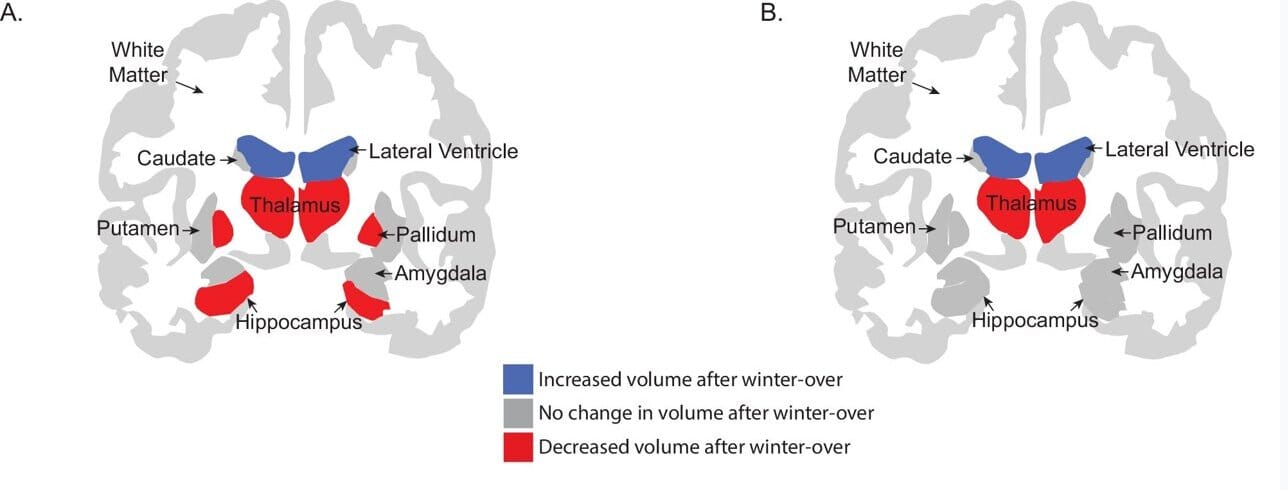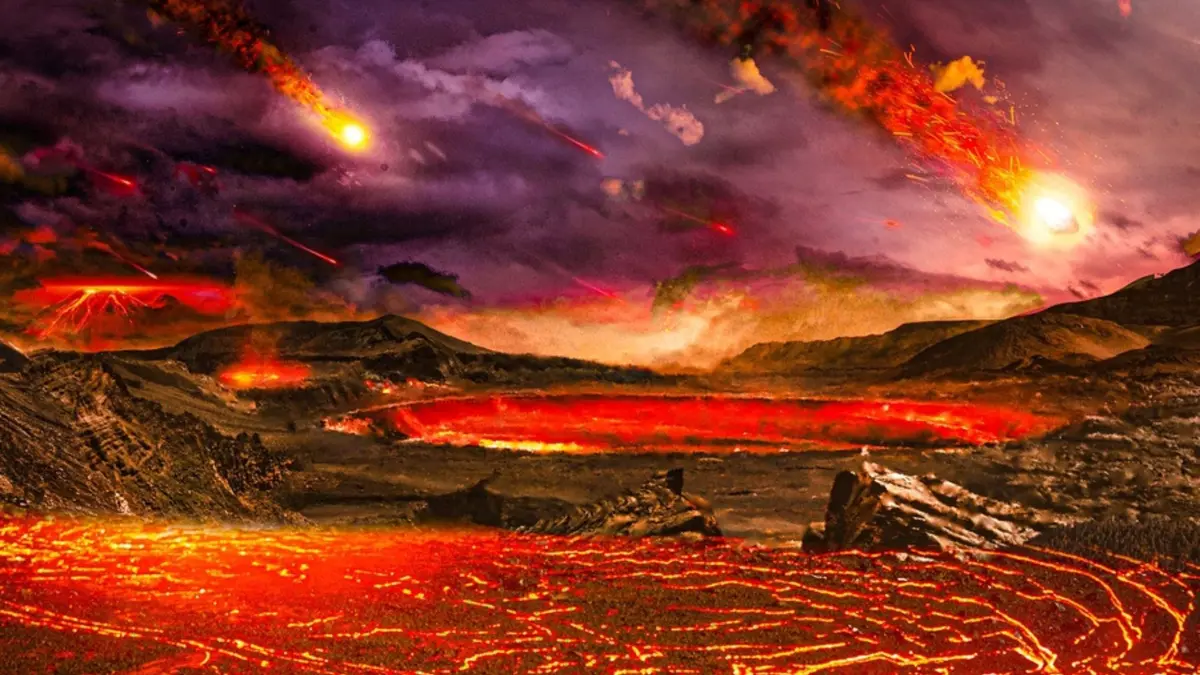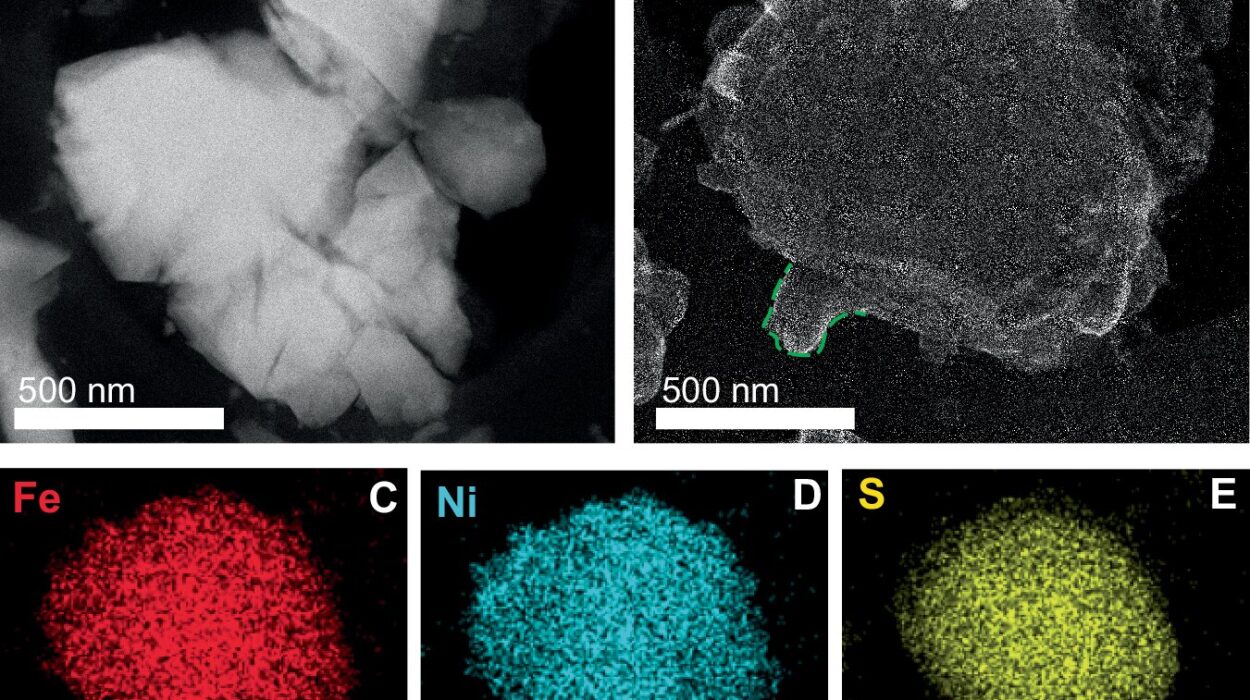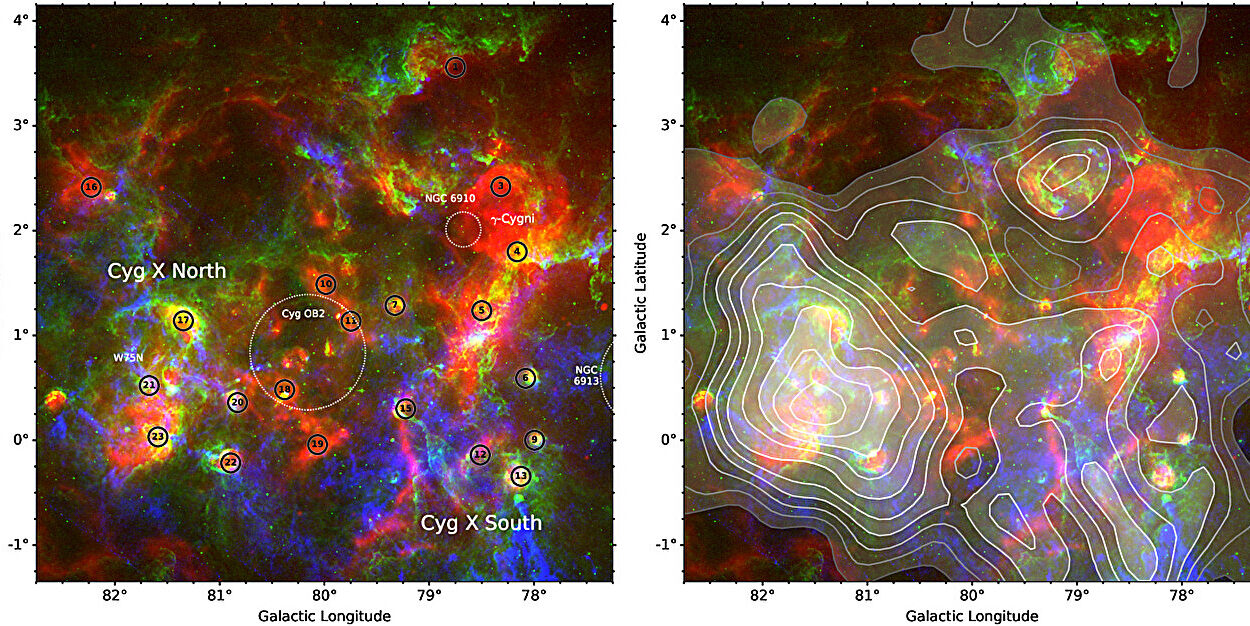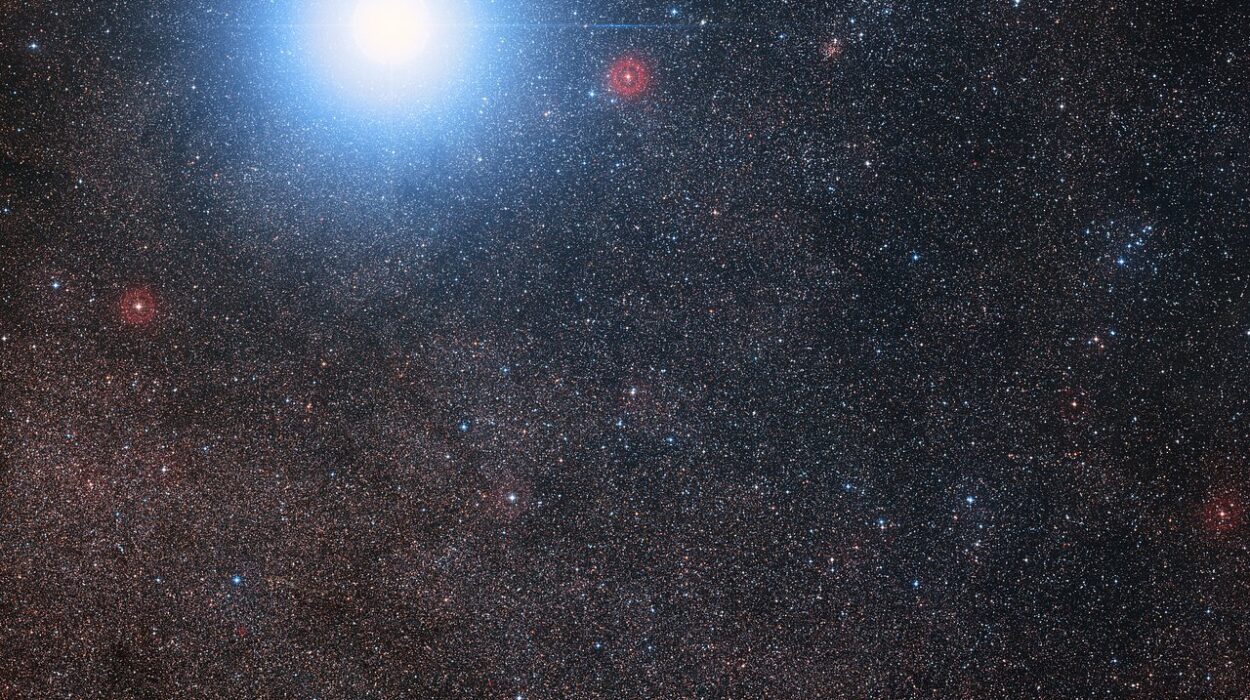At the bottom of the world, where temperatures plunge below -80°C and the sun disappears for months, a rare breed of humans spends the winter in complete isolation. Concordia Station, perched high on the Antarctic plateau at over 3,200 meters elevation, offers an environment so extreme, so remote, and so unforgiving, that even the air is thin and unforgiving. There is no rescue in winter. No new supplies. No face-to-face contact with the outside world. It is one of the loneliest, coldest places humans have ever dared to inhabit—and one of the best terrestrial mirrors of life in deep space.
Researchers from the University of Pennsylvania, collaborating with the European Space Agency and other institutions, have seized this opportunity to study what happens to the brain when it is subjected to months of environmental monotony, social confinement, and disrupted biological rhythms. Their results, published in npj Microgravity in a paper titled “Transient gray matter decline during Antarctic isolation: Roles of sleep, exercise, and cognition,” open a stark window into the vulnerable human mind—and what it may endure during long-duration missions to Mars or beyond.
When Isolation Becomes the Experiment
Most people can endure a few days of solitude, maybe even enjoy it. But isolation isn’t merely about being alone. It’s about the absence of change, the absence of escape, the psychological toll of sameness day after day, and the relentless undercurrent of being trapped—emotionally, physically, and socially. At Concordia Station, crew members experience not only this intense social isolation but also environmental challenges that mimic those in outer space: high-altitude hypoxia, constant low pressure, frigid temperatures, and long stretches of sensory deprivation.
To understand what this does to the brain, researchers conducted a longitudinal study involving MRI scans on two overwintering crews in 2015 and 2016. Each group, totaling 25 individuals, was scanned before they departed for Antarctica, again immediately after returning from their 13-month mission, and once more roughly five months after reintegration into normal life. Their results were compared against a control group of 25 healthy participants in Germany who lived normal, grounded lives and were scanned at similar intervals.
The question wasn’t just whether the brain would change—it was how deeply, how widely, and whether it could heal once exposed to the sunlight of society again.
Gray Matter in Retreat
The findings were as stark as the Antarctic landscape.
Significant decreases in gray matter volume were observed in multiple regions of the brain—most notably in the parietal and temporal lobes, areas responsible for sensory integration, spatial navigation, and memory formation. This was not subtle shrinkage, but measurable structural loss that had occurred over the course of the year-long isolation.
The hippocampus, the brain’s key player in learning and memory, also showed volume reductions. So did the pallidum, which contributes to motor control and motivation. Even the thalamus, the central hub for sensory signals and consciousness, shrank—and unlike most other regions, its volume remained reduced even five months after the mission ended.
These losses were not the result of a singular trauma or event. Instead, they emerged as the slow, quiet consequence of living in an environment designed for survival, not stimulation. No crowds. No trees. No smells. No novelty. Just endless snow, routine, and the same few faces.
Yet, most of these gray matter losses proved to be temporary. By the five-month follow-up, most affected brain regions had returned to baseline. The hippocampus rebounded. The temporal and parietal lobes showed resilience. Only the thalamus, that gateway to awareness, lagged behind—perhaps a clue to something more stubborn or profound.
The Strange Link Between Shrinking Brains and Sharper Minds
If the structural changes were concerning, the behavioral data was perplexing.
Crew members whose brains showed the greatest gray matter loss paradoxically performed better on certain cognitive tasks, especially those involving attention, reaction speed, and problem solving. It’s as if the brain, while shedding some of its structure, was sharpening its function—perhaps streamlining itself under pressure like a machine in survival mode.
The researchers called this “puzzling,” but not entirely without precedent. Other studies in extreme environments, from submarines to polar expeditions, have observed similar phenomena—where the brain adapts to monotony and confinement by becoming more efficient at processing the limited stimuli it receives.
This raises a provocative question: Could temporary structural loss be part of an adaptive strategy rather than purely a sign of damage? Or does it hint at a deeper neurological cost that only manifests later?
White Matter, Fluid Shifts, and Ventricular Expansion
The study didn’t stop at gray matter. It also examined white matter—the bundles of myelinated fibers that carry signals between neurons and across the brain. White matter volume also decreased immediately post-mission, though these reductions reversed by the follow-up.
More curiously, the lateral, third, and fourth ventricles—fluid-filled spaces in the brain—expanded. The lateral and third ventricles remained enlarged even five months later. This kind of expansion has been noted in astronauts returning from long-duration space missions, suggesting a link between environmental pressures in ICE (isolated, confined, extreme) environments and alterations in cerebrospinal fluid dynamics.
Cerebrospinal fluid itself did not increase in volume, but its distribution may have changed. This ventricular expansion could hint at a pressure imbalance, a brain that is subtly shifting in its container due to prolonged environmental stress—a concern for astronauts living in zero-gravity, where fluid redistribution is an ongoing challenge.
The Protective Power of Sleep and Sweat
Amid this neural reshaping, one variable emerged as a consistent protector: sleep.
Crew members who experienced better sleep quality—longer duration, higher efficiency, fewer awakenings—tended to preserve more gray matter in key areas. Sleep, it turns out, isn’t just rest for the body. It is nourishment for the brain. In the icy darkness of Antarctica, where circadian rhythms are scrambled and dreams are often elusive, those who clung to consistent sleep schedules fared best.
Exercise was another powerful shield. Those who used the station’s gym with high levels of physical exertion were more likely to maintain healthy brain volume. This wasn’t just about staying fit or killing time. It was about preserving neural architecture under siege from stress, isolation, and sensory deprivation. Physical movement appears to stimulate brain-derived neurotrophic factors—compounds that help neurons survive, grow, and connect.
In environments where almost everything works against the brain’s stability, sleep and exercise became biological countermeasures—simple, human tools against complex neuroanatomical risks.
Why This Matters for Life Beyond Earth
As humankind prepares for deeper and longer space missions—ones that will keep astronauts in ICE environments for months or even years—the lessons from Antarctica are not academic. They are urgent.
Living on the moon, or more perilously on Mars, will mean prolonged confinement in artificial habitats, limited social interaction, disrupted sleep cycles due to altered day-night rhythms, and no immediate return option. The psychological and neurological pressures will be immense, and failure to mitigate them could threaten mission success—or worse.
What Concordia teaches us is that the brain does not passively endure such conditions. It changes—sometimes in ways that reverse, sometimes in ways that linger. The thalamic shrinkage, the persistent ventricular expansion, the paradoxical boost in performance—these are not just curiosities. They are clues to how the brain copes, suffers, adapts, and survives in alien worlds.
Moreover, the protective effects of sleep and exercise offer a roadmap. If we want to send humans safely to Mars and back, we must prioritize not just fuel and food but dreams and sweat—habitats designed to protect circadian health, exercise regimes tailored to brain preservation, and interventions ready to rewire resilience.
The Long Shadow of Chronic Stress
What happens in Concordia is not a sudden catastrophe but a slow erosion. Chronic stress in ICE environments acts not like a hammer but like water—dripping, relentless, shaping the brain over time.
The neuroanatomical changes observed in the study were likely the sum of many pressures: mild but persistent hypoxia due to high altitude, monotony of environment and routine, emotional stress from limited social outlets, and altered sleep patterns caused by constant daylight or darkness.
This multifactorial stress is eerily similar to what astronauts will face. And unlike the stress of a trauma—sharp and sudden—it is more insidious. It bypasses panic and seeps into the roots of cognition and emotion, changing the architecture of memory, perception, and even identity.
Understanding this process is key to developing interventions—not just for astronauts but also for people on Earth who face ICE-like environments: the chronically ill, the elderly in isolation, submarine crews, and even prisoners in long-term confinement.
A Hopeful Brain
There is a silver lining. The fact that most gray and white matter changes reversed within months speaks to the brain’s incredible plasticity. Even under siege, it retains the ability to regenerate, to remember its original form. The findings point to neuroplasticity not as an abstract miracle but as a biological fact—one that can be guided, encouraged, and supported.
But it is not automatic. The differences observed among crew members show that not all brains bounce back equally. Those who sleep better, move more, and engage their minds fare better. Recovery is not just a matter of time—it is a matter of design, habit, and care.
Toward a Neuroscience of Exploration
Concordia Station is not just a cold outpost. It is a living laboratory where the future of human spaceflight is being quietly written—not in rockets, but in neurons. The MRI scans taken there are not just medical data. They are maps of resilience, fragility, and adaptation.
As we reach for the stars, we must carry not only our ambitions but our biology. The brain that evolved in warm caves and forest paths is now being tested in places utterly foreign to its design. And yet, it bends. It reshapes. It adapts.
That adaptation is not free. It comes with costs we are just beginning to measure. But with knowledge comes power. With vigilance comes preparedness. With sleep and sweat, even fragile gray matter can endure a white world—or a red one.
The ice of Antarctica is melting under climate change, but its lessons remain frozen in time. They remind us that exploration is not only about ships and stations. It is about the minds that endure them.
And those minds, fragile yet resilient, are the most complex frontier we have ever dared to cross.
Reference: David Roalf et al, Transient gray matter decline during antarctic isolation: Roles of sleep, exercise, and cognition, npj Microgravity (2025). DOI: 10.1038/s41526-025-00497-6
